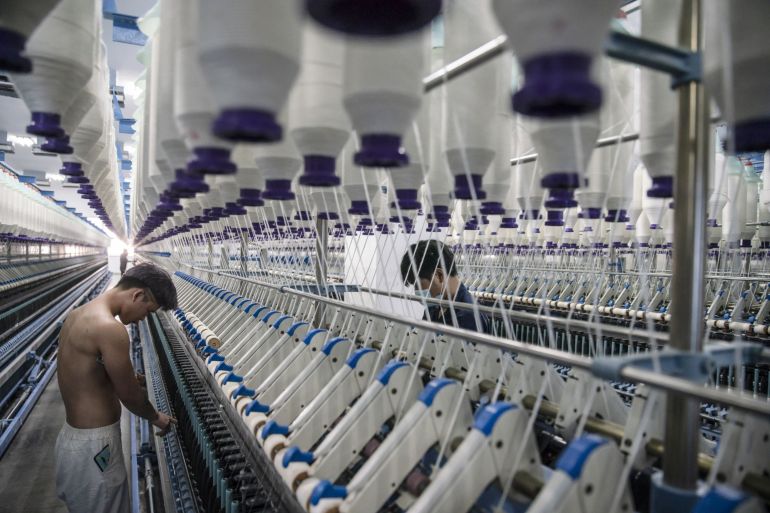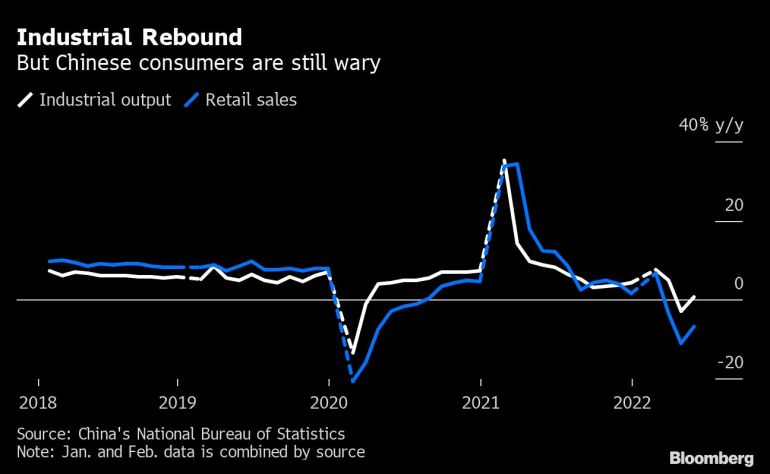China’s economy showed recovery sparks in May but consumers wary
Industrial production rose unexpectedly in May on easing of COVID curbs but consumer spending remained weak.

China’s economy showed signs of recovery in May after slumping in the prior month, as industrial production rose unexpectedly. But consumption was still weak, underlining the challenge for policymakers amid the persistent drag from strict COVID curbs.
The data, however, provides a path to revitalise growth in the world’s second-biggest economy after businesses and consumers were hit hard by full or partial lockdowns in dozens of cities in March and April, including a protracted shutdown in commercial centre Shanghai.
Keep reading
list of 4 itemsCan Biden’s Asia economic plan counter China’s influence there?
China loosens COVID rules amid scepticism over full reopening
China mocks Biden’s economic pact for failing to lower tariffs
Industrial output grew 0.7 percent in May from a year earlier, after falling 2.9 percent in April, data from the National Bureau of Statistics (NBS) showed on Wednesday. That compared with a 0.7 percent drop expected by analysts in a Reuters news agency poll.
The uptick in the industrial sector was underpinned by the easing of COVID curbs and strong global demand. China’s exports grew at a double-digit pace in May, shattering expectations as factories restarted and logistics snags eased.
The mining sector led the way with output up 7 percent in May from a year ago, while the manufacturing industry eked out a meagre 0.1 percent growth, mostly driven by the production of new energy vehicles which surged 108.3 percent year-on-year.
“Overall, our country’s economy overcame the adverse impact from COVID [in May] and was showing a recovery momentum,” NBS Spokesperson Fu Linghui told a press conference, adding that he expects the revival to improve further in June due to policy support.
“However, the international environment is still complex and severe, with greater uncertainties from outside. Our domestic recovery is still at its initial stage with the growth of key indicators at low levels. The foundations for recovery are yet to be consolidated.”
Retail sales slipped
That caution was underscored in consumption data, which remained weak as shoppers were confined to their homes in Shanghai and other cities. Retail sales slipped another 6.7 percent in May from a year earlier, on top of an 11.1 percent contraction the previous month.
They were slightly better than the forecast of a 7.1 percent fall due to the increased spending on basic goods such as grains, oils as well as food and beverages.
Industry data showed China sold 1.37 million passenger cars last month, down 17.3 percent from a year earlier, narrowing the decline of 35.7 percent in April.
Fixed asset investment, a key indicator tracked by policymakers looking to prop up the economy, rose 6.2 percent in the first five months, compared with an expected 6 percent rise and a 6.8 percent gain in the first four months.
China’s property sales fell at a slower pace in May, separate official data showed on Wednesday, supported by a slew of easing policy steps to boost demand amid the tight COVID-19 curbs.
The government has been accelerating infrastructure spending to boost investment. China’s cabinet has also announced a package of 33 measures covering fiscal, financial, investment and industrial policies to revive its pandemic-ravaged economy.
The nationwide survey-based jobless rate fell to 5.9 percent in May from 6.1 percent in April, still above the government’s 2022 target of below 5.5 percent. In particular, the surveyed jobless rate in 31 major cities picked up to 6.9 percent, the highest on record.
Some economists expect employment to worsen before it gets better, with a record number of graduates entering the workforce in the next three months.
China has set an annual economic growth target of about 5.5 percent this year, but many economists believe that is increasingly out of reach.
Chinese banks extended 1.89 trillion yuan ($281bn) in new loans in May, nearly tripling April’s tally and beating expectations. But 38 percent of the new monthly loans were in the form of short-term bill financing, suggesting real credit demand still remains weak.
The central bank on Wednesday kept the medium-term policy rate unchanged for a fifth straight month, matching market expectations.
New lockdown fears loom
While the world’s biggest manufacturer reported better-than-expected export growth in May, the subdued external demand due to the Ukraine war and robust production recovery of Southeast Asian nations threaten the country’s trade outlook.
Fears of new lockdowns also loom large under China’s zero-COVID policy.
One week after the reopening of Shanghai, the local government ordered 15 of the city’s 16 districts to undertake mass testing to contain a jump in cases tied to a hair salon.
Authorities in Beijing warned on Tuesday that the city of 22 million was in a “race against time” to get to grips with its most serious outbreak since the pandemic began.
Any potential lockdown and supply-chain disruption risks amid future COVID-19 outbreaks may constrain the rebound of the economy as Beijing has shown no sign of easing its zero-COVID policy, analysts say.
